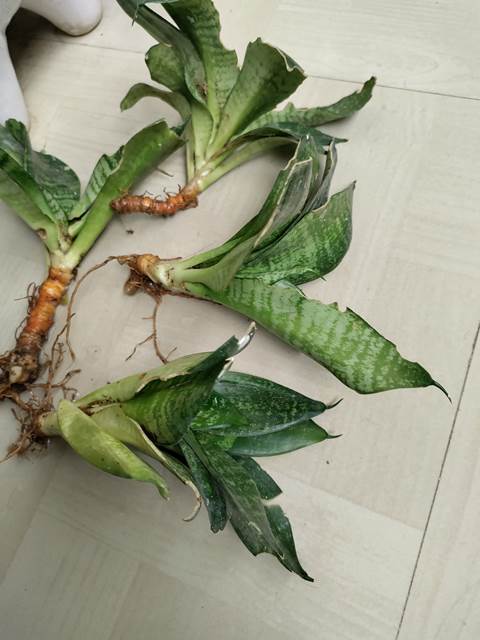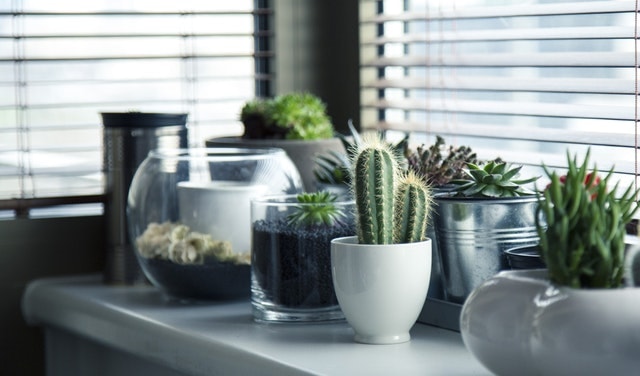Last Updated on 3 years by Namrata
Dracaena trifasciata, popularly known as snake plant, is one of the preferable and hardy houseplants. The name Dracaena originates from ancient Greek, which means a female dragon. This name is appropriate for these plants as they feature stiff and sword-like leaves and a height between six inches to eight feet tall. They are also hardy and not easily destructible.
Snake plants come in different colors, but green-banded leaves with a yellow border are the most famous. One of the reasons people love to grow snake plants is that it is easy to expand nature. These houseplants thrive in bright light or almost dark corners of the house.
It means you can propagate it in indoor light. However, if you keep it in direct light, it will boost its growth. You can also plant and repot it in the spring season.
So, you can see that snake plants or dracaena trifasciata are one of the least demanding houseplants to grow indoors. They grow with minimal attention and adapt to new conditions and locations without difficulty. If you know some techniques regarding its propagation and caring, you can ensure that your snake plant stays at its spiky best. This article will discuss a lot of information like benefits, growing tips, soil and water requirements, and many other details regarding snake plants. Hence, go through the below segments to learn all these.
Benefits of a Dracaena trifasciata (Snake plant)
As you might know, people love to grow many household plants for decoration and increase the aesthetic value of their abode. But did you know that some of these houseplants also have certain health benefits? The snake plant or dracaena trifasciatais one such plant that is known for both looking good and offering many benefits. So, keep going through the below points to know all the benefits of growing snake plants in your living place.
- Enhances air quality
Like many other household succulents, snake plants increase indoor air quality. These plants efficiently absorb many pollutants like CO2, benzene, formaldehyde, xylene, trichloroethylene, toluene, and more. These pollutants enter houses through paints, electrical appliances, building materials, carpets, furnishings, and new clothes. Direct exposure to these toxic pollutants leads to mild to serious health issues like cancer, headache, asthma, anemia, kidney disease, marrow disease, DNA mutation, and so on. But as dracaena absorbs all these pollutants, it is better to keep them in your house to keep the indoor air clean. The snake plant can convert CO2 into oxygen and efficiently boost the air quality. So, it is one of the key advantages why you should propagate snake plants in your house.
- Useful against allergies
Snake plants or dracaena trifasciatacan reduce the impact of some airborne allergens like dander and dust. As these house plants release oxygen and add moisture to the air, they are effective against health-related issues like allergies and respiratory problems. Therefore, this is a definite benefit that you should take advantage of by propagating snake plants in your place.
- Boosts mental health and well-being
Irrespective of whether you are a student or a working professional, you can never concentrate on anything and feel frustrated if your mental health is not perfect. One of the most effective ways to boost mental health is propagating snake plants. These houseplants enhance cognitive function, concentration, memory, attention, and mental well-being. As a result of these significant advantages, it is imperative to grow snake plants in schools and workplaces. You might not believe that modern medical science uses horticultural therapy for mental health treatment. Hence, all medical facilities need to propagate these plants to reap their benefits.
- Enhances humidity
During photosynthesis, snake plants release moisture in the air. So, if you are living in a dry location, you can keep a few snake plants to increase the humidity levels. In this way, you can also prevent many respiratory issues at bay because dry air contributes to many such health hazards. Besides, these plants are also effective against dry skin, sore throats, and dry coughs.
- Offer relief from some physical ailments
Snake plants can also help you get relief from some minor physical ailments. For instance, it heals skin burns and wounds, reduces inflammation, relieves headaches, supports the immune system, and keeps blood pressure in check. So, why not take advantage of these tiny houseplants by giving little care and attention?
- Increases aesthetic value
Snake plants are preferable for their ornamental value. The long leaves create a flamboyant image wherever you keep them. Besides, they develop woody stems, become tall, and add a bright splash of texture when it develops. Not only this, but you can also keep variegated snake plants for contrasting colors. In short, they are perfect for decorating your place, and you can increase your house’s aesthetic value with dracaena trifasciata.
- Absorbs lead
As you might know, lead, or Pb is a toxic metal that causes many health complications like breathing issues, stomach pain, memory loss, loss of appetite, weakness, low concentration, and others. Its direct exposure for a long time can even kill you. But by keeping snake plants in your house, you can avoid such issues as these plants absorb lead efficiently. Hence, it is another significant advantage of growing snake plants.
- Needs minimal maintenance
Snake plants are forgiving plants. It means they never demand a lot of care and attention. They are easily adaptable to low-light conditions and frequent watering. It is another reason why people love to grow these houseplants.
MORE POSTS: Philodendron Xanadu Propagation and Care
How to Propagate Dracaena trifasciata
So, after knowing the above benefits, you will want to propagate snake plants in your house. Learning how to grow a snake plant is easy if you select one of three methods. You can propagate snake plants through leaf cuttings or by the division method. To know more comprehensive details about the processes, read the below segment.
So, after knowing the above benefits, you will want to propagate snake plants in your house. Learning how to grow a snake plant is easy if you select one of three methods. You can propagate snake plants through leaf cuttings or by the division method. To know more comprehensive details about the processes, read the below segment.
Dracaena trifasciata propagation through leaf cuttings
If you want to grow dracaena trifasciata or snake plants through leaf cuttings, you need to learn the two methods. The first method is done by water and the second one is through the soil. So, let us start with the first method.
1. Snake plant propagation in water
Most snake plant lovers and gardeners prefer to propagate by cutting the leaves of snake plants in water. To perform this method, you need to gather the below tools or supplies.
Tools or supplies
- Some cotton balls
- Paper towel
- Rubbing or Isopropyl alcohol
- Scissors
- Drinking a glass or tall bowl
- Distilled or filtered water
Instructions
After collecting the above tools, you need to start the propagation process in the following way.
Step-1: First, take a cotton ball and dip it into the rubbing alcohol.
Step-2: Then, wipe down the scissor blades with the wet cotton ball to remove germs and viruses.
Step-3: Leave the scissor for drying and wait for some time.
Step-4: You need to select the healthy leaves from your snake plant and gently cut them individually near the soil levels.
Step-5: After that, place the cut leaves on a paper towel and allow them to dry.
Step-6: In this step, add around 4-6 inch water to the glass or bowl and place the leaves above the cut end. Remember that you should keep the bowl in a place so that it can receive indirect light.
Step-7: Change the water every two days, and after a few days, you will see its roots coming out.
Step-8: When the roots are about 2 inches long, you need to remove the leaves gently from the water.
Step-9: Finally, the leaves are ready to be planted in a soilless potting mixture.
2. Snake plant propagation in soil
The basic process of snake plant propagation in soil is the same. First, collect the below tools and follow the below-listed instructions.
Tools or supplies
- Cotton balls
- Gardening gloves
- Paper towel
- Rubbing alcohol
- Scissors
- Bowl and pot
- Rooting hormone
- Gardening trowel
- Soilless potting mix
Instructions
Step-1: First, dip the cotton ball into the Isopropyl alcohol to eliminate harmful germs and viruses from the scissor blades.
Step-2: Next, cut the healthy leaves and place them on a paper towel.
Step-3: If you wish to stimulate root growth, you can dip the cut end of the leaves into the rooting hormone
Step-4: Wait for 2-3 days until all the cut leaves develop a callous.
Step-5: You can plant the rooted leaves in the soilless mixture after the callous development.
Step-6: To plant them adequately, you need to put the end of the leaves by holding them in place. You can use a gardening trowel to fill the mixture around the leaves.
Step-7: You should leave the leaves untouched for at least two days before watering and also need to keep the pot in a bright area.
3. Snake plant propagation by division
The most hassle-free or easy way to propagate snake plant or dracaena trifasciata is by division. It is the most preferred process for anyone with a variegated plant to preserve the coloring. To propagate a snake plant by division, you first need to collect the below supplies.
Tools or supplies
- Gardening gloves
- Pot
- Soilless mixture
- Large snake plant
Instructions
After collecting the above supplies, you can begin the propagation process in the following ways.
Step-1: First, wear a pair of gardening gloves
Step-2: Next, separate a clump of snake plant leaves and the roots from the main section of the plant. This division will provide you with a clump of snake leaves with its rooting system.
Step-3: You can simply place the separated clump in the pot.
Step-4: Finally, fill the pot carefully with the soilless mix and water the plant to moisten it.

4. Snake plant propagation by rhizome
Besides the above ways, you can also propagate snake plants by rhizome. A rhizome is nothing but a stem that grows horizontally and underground. In snake or dracaena trifasciata plants, this stem will have v send-off shoots called pups. You can use pups to grow your new snake plants. But if you do not have the pups, you can still propagate these plants by using the rhizome. To execute the propagation process, you should first keep the below things organized.
Tools or supplies
- Snake plant
- Newspaper or paper towel
- Knife or shears
- Separate pots for each rhizome
- Potting mixture
Instructions
You now need to follow the below procedures to grow snake plants by rhizome.
Step-1: To grow snake plants by rhizome, you first need to lay our snake plant on the paper on its side by sliding it carefully out of the pot.
Step-2: Then, you need to look for rhizomes under the soil. For this, you need to search for whitish-looking stems that resemble garlic cloves.
Step-3: After that, take a knife or shears and cut the rhizome from the plant base. Take proper attention to avoid root damage.
Step-4: In the fourth step, you need to enable the rhizome to be callous over for a few days.
Step-5: After the callous formation, you can plant the rhizome by filling the pot with potting mixture.
How to Care for Dracaena trifasciata
To care for dracaena trifasciata or snake plants, you need to keep the plant in bright light or partial shade. The plant grows adequately in loose and well-draining soil. Besides, you should water these houseplants only when the soil dries. These plants also hate extra humidity, and they grow best in temperatures ranging from 70°F – 90°F or 21°C – 32°C. To know more about the caring of snake plants, go through the below segment.
- Soil
As told before, these houseplants prefer to grow in a well-draining soil mixture. You can use a soilless potting mix to prevent root rot as it offers an adequate drainage system. Apart from this, you can plant snake plants in a terracotta pot as it can remove water from the saucer.
- Water
You should only water your snake plant when its soil completely dries. Besides, you need to take proper care while watering it in winter.
You only need to keep the soil moist to offer your plants healthy growth in the cold season. Also, you should avoid getting the snake plant leaves wet while watering as it might give birth to many diseases.
- Light and Food
As you have learned, snake plants thrive best in bright light. As a result, you need to place your plants in bright yet indirect light. When it comes to fertilizing, you can feed your plants in the growing season with an all-purpose snake plant food. But you should avoid feeding them after the growing season ends.
- Humidity
Snake plants can thrive in average room humidity. If you propagate these houseplants in bright light and warm temperatures and water them when the soil dries, you do not need to bother about humidity.
But if you stay in hot weather, you can often wipe the snake plant leaves with a damp cloth.
MORE POSTS: How to Grow and Care for Chia Sprouts Indoors
When to water Dracaena trifasciata?
As you understand, watering any houseplant is challenging, especially for amateur gardeners. There is no fixed watering schedule for houseplants as the watering amount and duration depend on light, soil, temperature, and humidity. But if you have snake plants, you need to keep in mind that these plants are drought tolerant.
You should allow the soil to dry before watering again during the summer and spring seasons. Whereas in the winter season, you should water your snake plants only after a month or two, depending on the temperature.
Best soil for Dracaena trifasciata
If you want to accurately propagate dracaena trifasciata or snake plants, you can plant these houseplants in a porous and aerated soil with a proper drainage system. To make a well-drained potting mix, you can take one part of regular soil and mix it with two parts of perlite. This type of potting mixture is helpful for houseplants as it offers some nutrients and removes the excess water from the pot.
Is Dracaena trifasciata poisonous to cats?
In simple words, dracaena trifasciata or snake plants are poisonous to cats. These houseplants have a chemical compound named saponin in their leaves. Saponin is a toxic compound found in plants like legumes or spinach. Though it does not harm humans, it is poisonous to cats and dogs. If your cat accidentally chew snake plant leaves, it will suffer the below health hazard-
- Diarrhea to severe dehydration
- Loss of appetite
- Vomiting
- Weakness
- Abdominal pain
- Dilated pupils
- Depression
- Increased heart rate
- Drooling
- Nausea
- Depression
Therefore, you should keep your snake plants out of reach from your fur babies to protect them from the above health issues.
Final Takeaway
Snake plants are forgiving houseplants, and their propagation is also simple. Besides, as they are low-maintenance houseplants, you do not need to spend much of your resources and time on their care. Hence, if you have not snake plants yet, quickly purchase one and give some of your time to their caring. In the end, if you keep one, you will not only get several health benefits, but you can also enhance the aesthetic value of your living place. So, this is everything you need to know about how to grow and care for indoor dracaena trifasciata or snake plants.
MORE POSTS:
- 100+ Gardening Quotes and Captions for Instagram
- How long does it take rose cuttings to root in water?
- 15 Best Hanging Plants for a Shaded Porch




